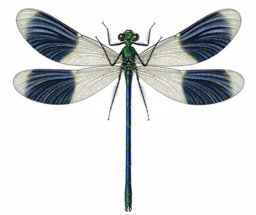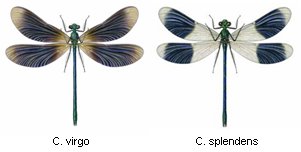| Calopteryx
splendens |
 |
|
Common Name:
|
Banded Demoiselle |
|
Odonata |
|
Order:
|
Odonata |
|
Suborder:
|
Zygoptera |
|
Family:
|
Calopterygidae |
|
Genus:
|
Calopteryx |
|
Species:
|
C. splendens |
|
|
| The
Name |
| Calopteryx splendens (Harris, 1782),
the Banded Demoiselle is a species of damselfly belonging to the family
Calopterygidae. It is often found along slow-flowing streams and rivers.
It is an Eurasian species occurring from the Atlantic coast eastwards to
Lake Baikal and north-western China.
The male has translucent wings which
each have a broad, dark iridescent blue-black spot (or band) across the
outer part. On immature dragonflies the spot is dark brown. The body can
be a metallic blue or blue-ish green.
The female has translucent, pale
green iridescent wings with a white patch near the tip, and a metallic
green body.

Comparing with similiar family species
Calopteryx virgo (Banded Agrion), the difference exists in extention of
the band in the wing patch. The wing patch of C. splendens starts
at the nodus but can reach up to the wing-tip in southern races. The nodus
is the sharp dip mid-way down the upper edge of the wing. That of the C.
virgo, the colouring on the wing starts before the nodus, further towards
the body, than the Banded demoiselle.
Demoiselles are damselflies that
belong to the family group called "Calopterygidae". This family includes
two large damselfly species: the Banded Demoiselle Calopteryx splendens
and the Beautiful Demoiselle Calopteryx virgo. Demoiselles have a graceful
butterfly-like fluttering flight and are usually seen flying over riverside
vegetation.
|
| The
Characteristics |
| This is a large damselfly with a
total length of up to 48 mm and a hindwing length of up to 36 mm. Male
has hind wing 27-32 mm, length of abdomen: 33-39 mm; female has hind wing:
31-36 mm and length of abdomen: 33-40 mm.
Males are usually territorial, but
large numbers can sometimes be found in lush bankside plants and on floating
objects. They court females by opening their wings and performing an aerial
dance. They are usually found among mature, slow-flowing streams and rivers
and sometimes canals.
|
| The
Reproduction and Development |
| Females can lay up to 10 eggs per
minute for 45 minutes. They lay in a wide variety of emergent or floating
plants, sometimes even submerging to do so.
The eggs hatch after 14 days. The
larvae have very long legs and are stick-shaped. They develop over two
years, usually, live amongst vegetation and tend to be most active at night.
They tolerate muddy water and overwinter buried in mud. When they are ready
to moult into an adult, larvae leave river and may climb up a suitable
reed or plant, move up to 100m prior to emergence and shed their skin.
Adults take 7-10 days to mature after
emergence and do not appear on breeding sites until then. Mature males
either hold territories on suitable egg-laying sites or perch on riverside
vegetation. Territorial males will court females, perching males attempt
to mate with any female. Females only visit rivers when ready to oviposit.
The usually appear end of April to
September according to locality.
|
| The
Distribution |
This species occurs throughout most
of Europe except for Iberia, southern Italy and Greece and most of Fennoscandia.
They also appear across Asia to China.
|
| The
Protection Status |
| Common, not theathened. |
|
References:
http://en.wikipedia.org/wiki/Banded_Demoiselle
|
The
Species on Stamps |
|
|
|
|
With courteous to Mr. Richard
Lewington for the Dragonfly Illustration
|
|
|
|
Home | Country
List | Species List
|